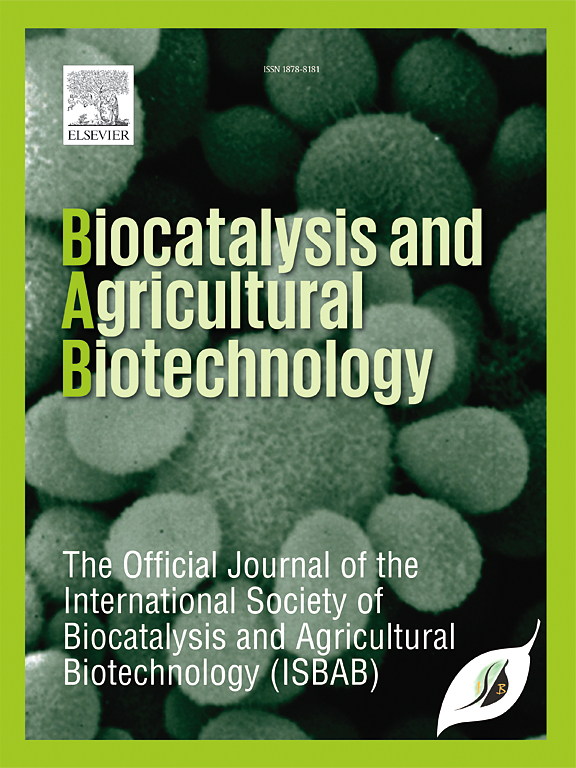添加硫酸铜后,lasalocidi链霉菌NTB 42的真黑素产量、酚类含量、类黄酮含量和抗氧化活性均有所提高
IF 3.4
Q2 BIOTECHNOLOGY & APPLIED MICROBIOLOGY
引用次数: 0
摘要
制药行业对天然色素(包括微生物黑色素)的需求正在迅速增加。真黑素是由链霉菌lasalocidi NTB 42产生的一种黑色色素,具有较高的抗氧化活性。这种颜料可以用硫酸铜(CuSO4.5H2O)大量生产。本研究旨在评价CuSO4.5H2O对S. lasalocidi NTB 42中真黑色素生成相关参数及抗氧化活性的影响。在生产培养基中添加0.04%的CuSO4.5H2O,酪氨酸酶活性显著提高4.52倍。此外,真黑素产量增加46.75倍(3.74 g/L),真黑素浓度增加1.83倍(875 mg/g真黑素干重),总酚含量(TPC)增加1.44倍(127.76 mg GAE/g真黑素),2,2-二苯基-1-苦基-肼基清除率(IC50)增加0.89倍(66.75 μg/mL),铁还原抗氧化能力增加7.68倍(875.95 mg AAE/g真黑素)(p <;0.05)。此外,添加0.03% CuSO4.5H2O可使总黄酮含量(TFC) (76.93 mg QE/g真黑素)提高1.30倍,总抗氧化能力(191.41 mg AAE/g真黑素)提高0.28倍(p <;0.05)。所得真黑素经UV-VIS和FT-IR表征,与先前发现的真黑素具有相同的性质。这些结果表明,0.03% ~ 0.04%的CuSO4.5H2O浓度显著提高了S. lasalocidi NTB 42的真黑色素生成、主要化合物水平和抗氧化活性。该研究强调了S. lasalocidi NTB 42在增加真黑色素生成和抗氧化活性方面的潜力,以满足作为抗氧化剂在制药应用中的需求。本文章由计算机程序翻译,如有差异,请以英文原文为准。

Improved eumelanin production, phenolic content, flavonoid content, and antioxidant activity by Streptomyces lasalocidi NTB 42 following copper sulfate supplementation
The demand for natural pigments, including microbial melanin, is rapidly increasing in the pharmaceutical industry. Eumelanin, a black pigment produced by Streptomyces lasalocidi NTB 42, exhibits high antioxidant activity. This pigment can be produced in large quantities using copper sulfate (CuSO4.5H2O). This study aimed to evaluate the effect of CuSO4.5H2O on various parameters related to eumelanin production in S. lasalocidi NTB 42 and antioxidant activity. The addition of 0.04 % CuSO4.5H2O to the production medium significantly enhanced tyrosinase activity by 4.52-fold. Additionally, it resulted in a 46.75-fold increase in eumelanin production (3.74 g/L), a 1.83-fold increase in eumelanin concentration (875 mg/g eumelanin dry weight), a 1.44-fold increase in total phenolic content (TPC) (127.76 mg GAE/g eumelanin), a 0.89-fold increase in the 2,2-diphenyl-1-picryl-hydrazyl scavenging assay (IC50) (66.75 μg/mL), and a 7.68-fold increase in ferric reducing antioxidant power (875.95 mg AAE/g eumelanin) (p < 0.05). Furthermore, the addition of 0.03 % CuSO4.5H2O resulted in a 1.30-fold increase in total flavonoid content (TFC) (76.93 mg QE/g eumelanin) and a 0.328-fold increase in total antioxidant capacity (191.41 mg AAE/g eumelanin) (p < 0.05). The obtained eumelanin, which is characterized by UV–VIS and FT-IR analysis, has the same character as the previously found eumelanin. These findings suggest that CuSO4.5H2O concentrations between 0.03 % and 0.04 % significantly enhance eumelanin production, levels of major chemical compounds, and antioxidant activity in S. lasalocidi NTB 42. This study underscores the potential for increased eumelanin production and antioxidant activity of S. lasalocidi NTB 42 to meet the demands of pharmaceutical applications as an antioxidant agent.
求助全文
通过发布文献求助,成功后即可免费获取论文全文。
去求助
来源期刊

Biocatalysis and agricultural biotechnology
Agricultural and Biological Sciences-Agronomy and Crop Science
CiteScore
7.70
自引率
2.50%
发文量
308
审稿时长
48 days
期刊介绍:
Biocatalysis and Agricultural Biotechnology is the official journal of the International Society of Biocatalysis and Agricultural Biotechnology (ISBAB). The journal publishes high quality articles especially in the science and technology of biocatalysis, bioprocesses, agricultural biotechnology, biomedical biotechnology, and, if appropriate, from other related areas of biotechnology. The journal will publish peer-reviewed basic and applied research papers, authoritative reviews, and feature articles. The scope of the journal encompasses the research, industrial, and commercial aspects of biotechnology, including the areas of: biocatalysis; bioprocesses; food and agriculture; genetic engineering; molecular biology; healthcare and pharmaceuticals; biofuels; genomics; nanotechnology; environment and biodiversity; and bioremediation.
 求助内容:
求助内容: 应助结果提醒方式:
应助结果提醒方式:


